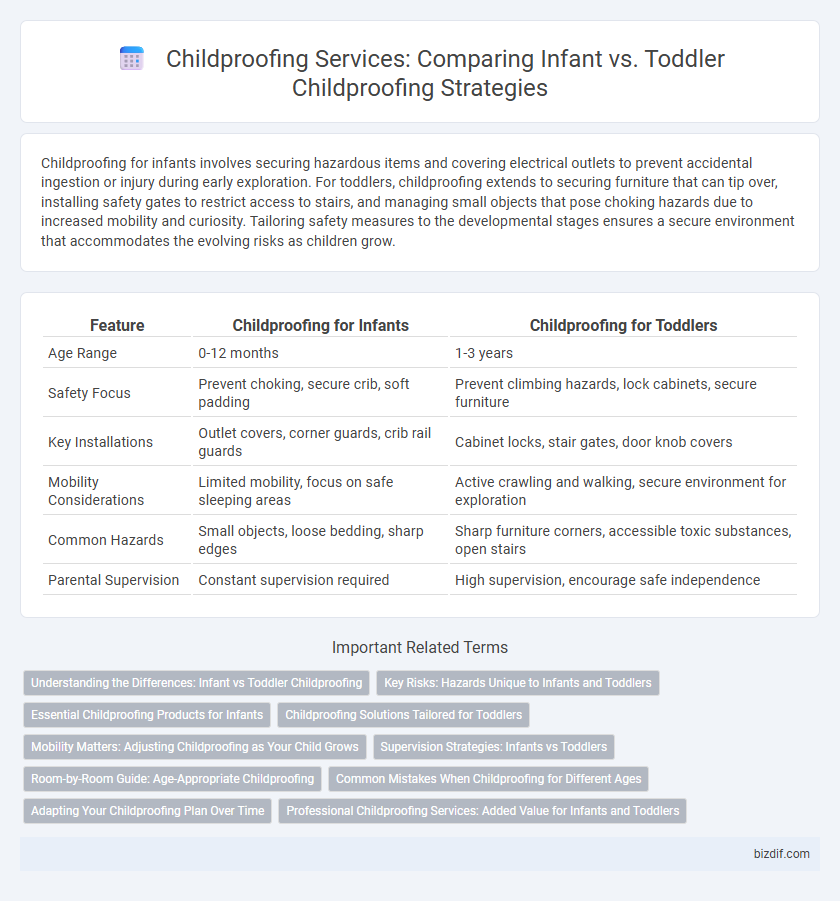Childproofing for infants involves securing hazardous items and covering electrical outlets to prevent accidental ingestion or injury during early exploration. For toddlers, childproofing extends to securing furniture that can tip over, installing safety gates to restrict access to stairs, and managing small objects that pose choking hazards due to increased mobility and curiosity. Tailoring safety measures to the developmental stages ensures a secure environment that accommodates the evolving risks as children grow.
Table of Comparison
| Feature | Childproofing for Infants | Childproofing for Toddlers |
|---|---|---|
| Age Range | 0-12 months | 1-3 years |
| Safety Focus | Prevent choking, secure crib, soft padding | Prevent climbing hazards, lock cabinets, secure furniture |
| Key Installations | Outlet covers, corner guards, crib rail guards | Cabinet locks, stair gates, door knob covers |
| Mobility Considerations | Limited mobility, focus on safe sleeping areas | Active crawling and walking, secure environment for exploration |
| Common Hazards | Small objects, loose bedding, sharp edges | Sharp furniture corners, accessible toxic substances, open stairs |
| Parental Supervision | Constant supervision required | High supervision, encourage safe independence |
Understanding the Differences: Infant vs Toddler Childproofing
Childproofing for infants primarily involves securing the environment to prevent access to hazards such as sharp edges, choking hazards, and unsecured furniture, emphasizing crib safety and outlet covers. Toddler childproofing requires addressing increased mobility and curiosity by installing safety gates, locking cabinets, and securing heavy furniture to prevent tipping. Understanding these developmental differences ensures tailored safety measures that effectively reduce injury risks at each stage.
Key Risks: Hazards Unique to Infants and Toddlers
Childproofing for infants prioritizes mitigating risks such as choking hazards from small objects, securing cribs to prevent entrapment, and ensuring safe sleep environments free from soft bedding. Toddler childproofing emphasizes preventing falls from furniture or stairs, blocking access to sharp or heavy objects, and securing cabinets with harmful substances or choking risks due to toddlers' increased mobility and curiosity. Understanding these distinct hazards ensures tailored safety measures that effectively protect each developmental stage.
Essential Childproofing Products for Infants
Essential childproofing products for infants include outlet covers, cabinet locks, and corner protectors to prevent electrical hazards and injuries from sharp edges. Secure crib rails and baby gates are crucial to ensure infants remain in safe areas while exploring their surroundings. These tools prioritize safety during the early mobility stages, contrasting with toddler-proofing, which often involves more advanced locks and furniture anchors for increased mobility and curiosity.
Childproofing Solutions Tailored for Toddlers
Childproofing solutions tailored for toddlers prioritize securing furniture edges, installing safety gates, and using outlet covers to prevent access to electrical hazards, reflecting their increased mobility and curiosity compared to infants. Toddlers require durable locks on cabinets containing cleaning supplies and medications, as they engage in more independent exploration than younger babies. Effective toddler-proofing strategies focus on creating a safe environment that accommodates their active behavior while minimizing potential risks.
Mobility Matters: Adjusting Childproofing as Your Child Grows
Childproofing for infants prioritizes securing stationary hazards like outlet covers and cabinet locks, recognizing limited mobility in newborns and early crawlers. As toddlers gain mobility through walking and climbing, childproofing shifts to include stair gates, corner bumpers, and securing heavy furniture to prevent tipping. Regularly updating safety measures ensures protection aligns with evolving motor skills and exploratory behaviors.
Supervision Strategies: Infants vs Toddlers
Supervision strategies for childproofing infants focus on constant eye contact and creating a safe environment with cushioned play areas and secured furniture to prevent injuries. For toddlers, supervision shifts toward monitoring their increased mobility and curiosity, emphasizing the use of safety gates, locked cabinets, and teaching basic safety rules. Tailoring supervision approaches to developmental stages ensures stronger prevention of accidents and supports child safety effectively.
Room-by-Room Guide: Age-Appropriate Childproofing
Infant childproofing emphasizes securing hazardous items and installing soft corner bumpers in nurseries to prevent injuries, while toddler childproofing requires added measures like cabinet locks, outlet covers, and gate barriers throughout living areas to accommodate increased mobility and curiosity. Room-by-room, nurseries focus on crib safety and securing small objects, kitchens demand locks on cabinets and appliances, bathrooms need toilet locks and non-slip mats, and playrooms require padded flooring and toy organization. Tailoring childproofing strategies to the developmental stages of infants versus toddlers ensures a safer environment that addresses age-appropriate risks in each room.
Common Mistakes When Childproofing for Different Ages
Common mistakes when childproofing for infants include overlooking soft hazards like crib bumpers and neglecting secure cabinet locks, whereas for toddlers, failing to anchor heavy furniture and not covering electrical outlets pose significant risks. Many caregivers underestimate the mobility and curiosity of toddlers, leading to gaps in window guards and stair gates. Customizing childproofing strategies to developmental stages reduces injury risks and enhances home safety.
Adapting Your Childproofing Plan Over Time
Childproofing for infants centers on securing furniture edges, covering electrical outlets, and removing small objects to prevent choking hazards. As toddlers become more mobile and curious, childproofing adapts to include locking cabinets, installing safety gates, and securing heavy items to prevent climbing accidents. Regularly updating safety measures aligned with a child's developmental milestones ensures comprehensive protection in evolving environments.
Professional Childproofing Services: Added Value for Infants and Toddlers
Professional childproofing services offer tailored safety solutions that address the distinct developmental stages of infants and toddlers, ensuring age-appropriate hazard mitigation. For infants, emphasis is placed on securing cribs, softening sharp edges, and covering electrical outlets, while toddler childproofing prioritizes locking cabinets, securing furniture to prevent tipping, and installing safety gates. Expert assessments and customized installations provide comprehensive protection that adapts as children grow, significantly reducing injury risks in both age groups.
Childproofing for infants vs Childproofing for toddlers Infographic

 bizdif.com
bizdif.com